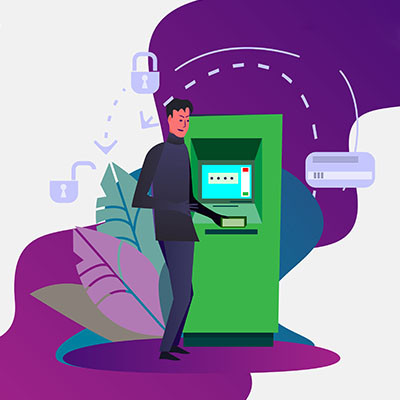Whether or not you believe acronyms are an acceptable form of speech, some people might use them habitually or instinctively even for business communications. Of course, they don’t have much place in this context, but habits are hard to break. To address this issue, one innovative thinker has created a tool that can help determine if the acronym “LOL” is sincere or not.
Coleman Technologies Blog
The holiday season is getting busier and busier every year and with less and less time afforded to shopping and getting ready for the holiday, you may have overlooked that special someone on your holiday shopping list. This week, we give you three gadgets that would be really nice last minute gifts for that technology lover in your life
It probably isn’t a question you’ve put much thought to, but tell me: who do you think feels the greatest impact from card skimming schemes, where a payment card’s data is captured so a cybercriminal can make use of the card’s associated account? While it isn’t a good situation for anyone, some are impacted more than others.
Power
To start, let’s go to perhaps the most basic need of any technology user: the energy required to keep their devices on in the first place. Let’s not split hairs—the average home office setup might not have sufficient outlets available for all the devices that need to be powered.
If this applies to you, you may appreciate someone giving you a nice surge protector to help expand the number of available outlets you have while simultaneously protecting the devices you plug in.
There are countless examples of IT turning to a reboot as a quick fix for technology issues in popular culture. Going back to August 4, 1999, Scott Adams’ syndicated comic strip Dilbert featured Dogbert working in tech support, interrupting a caller with the instruction to “Shut up and reboot.” The Channel 4 comedy, The IT Crowd, turned it into a catchphrase for one of its characters…

The joke has appeared in countless other places, including Supernatural, the long-running show that airs on The CW…

Even South Park used the concept as a joke, as Kyle effectively saves the world after the Internet stops by traveling to the “center of the Internet” and discovering that it is a giant router. I bet you can guess how Kyle fixes it:

As it turns out, this trope really is an example of art imitating life.
Why is Rebooting So Effective?
Well, let’s consider how much you actually do with your computer (or your mobile device, or your router, or your washing machine, or anything else that now has its own operating system) on a regular basis.
You start processes, you may install new programs, and that’s not even considering the massive amount of computing that goes on behind the scenes. A lot of these processes and activities will start things up in the background that are never really resolved, which means that your system resources are being used up. This usually has the biggest impact on your Random Access Memory, or RAM. Ultimately, your solutions aren’t able to work effectively any longer, and you see the effects.
However, rebooting inherently ends all of these processes, as they all require power in order to work. As a result, once the computer starts back up again, these processes are no longer running and impacting your system’s resources.
As a result, you have a better-working computer, and the IT stereotype is proven correct.
Keep in mind: if an issue seems to come back and persist despite a reboot (or multiple reboots) you likely have a bigger problem at hand. If this is the case, you can always lean on the professionals at Coleman Technologies to assist you with your technology.
Just don’t be surprised if we ask a particular question.
Subscribe to our blog for more great tips, IT tricks, and best practices!
Here, we’ve put together a list of suggestions for the different kinds of coworker you might have to provide a present for.
The Health-Conscious
Let’s face facts - the desk jobs that are typical of the office aren’t exactly the healthiest ones in the world, so there are plenty of gifts that are intended for the office worker who wants to fight the battle of the bulge.
From numerous standing desk and converter options, to chairs that require active sitting (like those big inflatable balls you sit on) or are specially designed with ergonomics in mind, to elliptical machines that fit under a desk, you have your choice of means to help decrease sedentary behavior in the naturally-sedentary office environment, or at least minimize its impact.
Want to take the more affordable route? Look into posters with yoga positions or rolled up yoga mats that can be stowed away. If your office has an outdoor space, a few outside gifts like frisbees, jump ropes, and hackysacks might be a big hit.
While you may not be able to give your coworker the ability to avoid the snacks in the break room, or the extra cupcakes that Susie from Human Resources brought in from her daughter’s 7th birthday party, you can at least help them fight off their effects.
The Productivity-Minded
We all have that coworker who likes to keep themselves as organized as possible, as the more organized they are, the more productive they can be. There are many gifts that may be perfect for such a person, especially with the new year following so closely behind the holidays. For instance, a personal calendar or planner is a popular tool that many people use, especially those who prefer to find it easier to remember their responsibilities if they record them in analog, rather than digital format.
Alternatively, you might consider getting such a person a means of keeping their space uncluttered and organized, such as an attachable storage shelf for their desk, or a case to help them keep their various peripherals, dongles, and doodads organized and easily portable.
Of course, one of the most common ways to boost productivity is to add an additional display, so you always have the option to invest in any of a variety of products that can accomplish this. There are additional monitors for both desktops and laptops, of course, but there are also docks that can turn a mobile device into an additional, interactive display. Of course, these can be pricier than a gift for a coworker should perhaps be, but there are also options with a much less considerable price tag - like a wireless phone charger or similar device.
The Fidgeter
We all have that coworker who tends to think with their hands - that person who needs something tactile to help organize their thoughts. This is a fairly easy person to buy a gift for, as there are plenty of “desk toys” out there that you can find - fidget spinners, levitating tops, and magnetic balls just being the start.
One word of warning - unless your coworkers are always listening to music while they work, or are exceptionally patient, you will probably want to make sure whatever tchotchke you decide to give someone is minimally disruptive. Otherwise, your gift may result in issues down the line.
Of course, you don’t necessarily need to give gifts that are just for the office. It’s always fun to get a more personalized gift for someone to use in their personal life, as it means that you have really gotten to know your coworkers.
What was the best gift you ever got from an office gift exchange? What would you hope to receive now? Share it in the comments - you never know, someone might see it and give it to you!
With global spending on IoT research and integration reaching $745 billion in 2019, the IoT is primed to be one of the largest single industries in the world in the future. Individuals, businesses, and governments are looking at the IoT for solutions to their problems. After all, the more information people have, the better decisions can be made. From the outset, it was said that this technology will transform the way we interact with machines and the way they will interact with each other, and only a few short years into a worldwide implementation, that mantra has proven to be true. Let’s look at where the IoT is growing most.
Industry
The huge annual jumps in IoT spending is largely driven by manufacturers, transportation, and utilities. Industrial IoT solutions provide companies and municipalities, alike, the link between their cloud-based software systems and their analysts, salesmen, and decision makers. This relationship is tenuous, however, and is closely monitored as a result. If a huge IoT strategy breaks even once, confidence in the platform is destroyed, leaving it an unreliable solution, regardless of the strengths of the technology.
Manufacturers and process managers that utilize IoT solutions absolutely need their systems to be as reliable as possible. That means security, which is the number one improvement that the next phase of IoT has to make. For years, IoT was only somewhat trustworthy because of the lack of integrated security many IoT devices were manufactured with. Today, with security an absolute must for the major undertakings it is being used for, security has improved, but only slightly. A dedication to creating IoT devices that have hardware and software systems that are secure and reliable will dictate just the ceiling of IoT effectiveness.
The Smart City
One of the most intriguing places the IoT has been utilized thus far is in the integration of automated utility systems inside what has been termed, “the smart city”. The smart city uses what are known as low power IoT connections. These devices deliver low bandwidth and power saving features that are perfectly suited to asset monitoring. They can be implemented for a variety of uses, including:
- Sensors built into city roadways to sense things like the subsistence of traffic congestion and wear and tear of roadways.
- Sensors built into bridges to sense degradation and the effect of seismic forces caused by geographical and traffic-based events.
- Sensors built into buildings to measure wind force, foundation subsistence, or seismic activity.
- Sensors in the interior of buildings to control foot-traffic, lighting, heating and air, and other systems humans rely on.
- Sensors on the street or on entryways that will provide facial recognition and reporting.
Unlike IoT-connected consumer goods, every IoT device deployed in a smart city would have a purpose that is beyond convenience. Every device would be placed to achieve a goal, improve the usability, longevity, and management of infrastructure, boosting resident safety and improving their access to services, cutting costs and limiting energy use, improving communications, and more.
One thing is for sure, the next phase of IoT implementation is going to challenge conventional thinking and deliver solutions that only a short time ago, were only imaginary. At Coleman Technologies we find technology fascinating. For more great technology information about innovative new tech, return to our blog regularly.
Let’s explore some of the risks that the IoT can present.
The Security Issues of the IoT
The Internet of Things has added utility to many devices, expanding their potential in ways that would otherwise be impossible. This has only been further augmented by the access to personal devices that many employees enjoy through Bring Your Own Device policies.
However, these benefits have come with an assortment of considerable risks alongside them. Devices that are a part of the IoT are notoriously vulnerable to many cyberattacks, which means that they could potentially be used as a point of access to your business’ network. From there, a cybercriminal has plenty of opportunities to create issues - whether that’s by stealing your data, hijacking your devices to be used in a botnet, or whatever their goal may be.
This problem is only exacerbated by the tendency for IoT devices to go without updates, whether through the negligence of the manufacturer or of the consumer. Without these updates, security flaws go unresolved, and the devices are thereby left vulnerable.
Consider how many devices are now manufactured that connect to the Internet. Smart watches and other wearables, smart speakers and televisions - really, almost anything with the word “smart” in its name - we have more or less surrounded ourselves with the Internet of Things. This includes the time we spend in the workplace, despite many of these devices not being visible on the network to IT. As a result, it has become almost impossible to track all the devices that attach to a network, which has developed into a new issue for businesses.
Shadow IoT
Thanks to the public demand for convenience and advanced functionality, more and more IoT devices are being manufactured all the time. If any of these devices makes its way into your office without the knowledge and approval of IT, you have a shadow IoT problem.
If you do, you aren’t alone.
In 2017, 100 percent of organizations surveyed by an IoT security firm were found to have consumer IoT devices on the network that qualified as shadow IoT. Another report, from 2018, stated that one-third of United States, United Kingdom, and German companies have over 1,000 shadow IT devices on their networks every day. Combine this with the security shortcomings discussed above, and you have a recipe for a cybersecurity disaster.
You may remember the Mirai botnet, which struck back in 2016. This botnet was built up of over 600,000 devices at its peak and focused primarily on IoT devices. Once these devices were identified by Mirai, they would be attacked and infected, adding more computing power to the botnet. Mirai is far from the only example, too… cybercriminals have been known to hack into IoT devices to gain network access, spy and listen in on conversations, and otherwise prove themselves to be a nuisance.
How to Minimize Shadow IoT
Clearly, shadow IoT isn’t a good thing for any organization. There are a few things you can do to help protect your business from the security issues that shadow IoT can cause.
- Accept IoT devices in the workplace. If your employees really want to use one of their devices at work, they’re going to. Instead of shooting down requests to bring in these devices, make it easier for your employees to do so through the proper channels - and make sure your employees are aware of these channels. Openness and cooperation can be effective tools as you try to get your team on the same page you’re on.
- Keep IoT devices separate. To better protect your network, you will want to consider utilizing a dedicated Wi-Fi network for IoT devices, configured to allow them to transmit the information they generate while blocking any incoming calls to them. This will help prevent threats from being transmitted to IoT devices.
- Seek out potential threats. Not all shadow IoT necessarily can be found on an organization’s network, as over 80 percent of the IoT is wireless. This means that you need to be monitoring your wireless signals for shadow IoT devices and networks.
Your business’ security is important - too important to be undermined by an insecure consumer device that was brought in without your knowledge. You need to get out ahead of shadow IoT, as well as the other threats that could do your business harm.
Coleman Technologies can help. Our professionals are well-versed in cybersecurity best practices and how to use them to your benefit. To find out more about what we can do for your business, reach out to us at (604) 513-9428.
To begin, let’s briefly review the basic principles of BYOD practices. In essence, rather than providing each employee with a company-supplied device, an employee is allowed to bring in a device that they own and leverage it for work purposes.
Why BYOD Has Become Popular in Workplaces
On the surface, BYOD seems to be the perfect solution - there are even statistics that help to support this position. For instance, companies who embrace BYOD practices save around $350 each year, per employee. Furthermore, using portable devices for work (much like what would be used as part of a Bring Your Own Device practice) has been shown to save employees approximately an hour each day, increasing their productivity by about a third.
This is just the tip of the BYOD-benefits iceberg. There are much more, including:
Access to Better Technology
If you were to list any business’ technology priorities, security and productivity should top the list… but oftentimes, frugality wins the day. Budgetary restrictions and a preference for tried-and-tested solutions frequently means that investments into more recent solutions are often pushed by the wayside. After all, what if the expensive new technology doesn’t work properly? This is frequently why businesses find themselves making due with solutions that really should be replaced. On the other hand, employees likely have no such qualms when they purchase their own devices.
BYOD policies allow a business’ employees to replace their outdated solutions with the reliability of newer, more up-to-date devices… leading to happier, more productive employees.
Reduced Financial Toll on the Business
Like we mentioned, it is fairly common for budgetary concerns to be the driving factor of many business decisions. It isn’t that the company doesn’t want to replace the aging workstations scattered around the office… it just isn’t in the budget. Before Bring Your Own Device emerged, businesses were stuck in a few different money pits. Between providing their employees with devices, maintaining and replacing these devices when they went faulty, and all the other expenses that come from keeping up an IT infrastructure, employers were stuck with a hefty bill.
Nowadays, with many people investing in their own devices and their accessibility, these expenses can largely evaporate. The employer’s investment can be effectively limited to securing access to these devices, allowing funds to be spent on other meaningful initiatives.
Employee Satisfaction
We’ve all experienced the struggle of trying to do work on equipment that just isn’t equipped for what we are trying to do. It can feel like trying to play Yahtzee with loaded dice - it just isn’t going to work, no matter how much effort is put forth. This is the other side of the example that preceded this one. If the aging workstations scattered around the office aren’t replaced due to budgetary concerns, some employees are going to be stuck using them… and they aren’t going to be happy.
As we alluded to as we described the effects that access to improved solutions can bring, an employee who isn’t being hamstrung by their technology is simply going to be more productive and happier with their working situation.
Clearly, BYOD isn’t something that should be dismissed without at least some consideration, but that isn’t to say that it is a perfect solution. There are also potential issues that need to be addressed as a BYOD policy is considered.
The Potential Issues of BYOD
Distractions
For every productivity application available on the Google Play Store, there is at least one application that is decidedly unproductive… at least, in terms of your business and its operations. While you could take steps to prevent these kinds of applications from appearing on devices that you provide, there isn’t much you can do about your employees downloading whatever they want onto their own.
Loss of Control
This is a big issue for businesses, as there are a multitude of ways that their losing control over the devices on their network could impact them. The policies that once prevented vulnerabilities from being leveraged can’t just be installed on an employee’s device without their consent, which many employees may be hesitant to give. This problem becomes even larger if an employee is fired or quits - what happens to the data on their device? How can a company be sure that a current employee isn’t putting sensitive company data at risk? What if the device is lost?
Compliance Shortcomings
Finally, you have to consider how your BYOD implementation will interact with any other compliances or requirements that your business is beholden to. In the past, a shockingly low number of IT leaders and professionals were confident that their BYOD policies met the standards placed by a variety of requirements, including HIPAA and Dodd-Frank.
How Can I Leverage BYOD Securely?
Fortunately, there are a few means of adopting a BYOD approach within your business while mitigating the concerns described above. The simplest way is to simply enforce a use policy, outlining the guidelines that your employees must follow if they wish to use their personal devices for work purposes.
Coleman Technologies can help you to create and enforce these guidelines, as well as optimize your use of your IT in many other ways. To learn more, reach out to our team by calling (604) 513-9428.
How Can BYOD Manifest Issues?
Unfortunately, for all its benefits, there is no shortage of drawbacks to BYOD - at least, if it is implemented without conscious deliberation and preparation. Here, we’ve listed a few such drawbacks:
Business and Personal Data Often Mix, but Shouldn’t
Do you really expect an employee to have a personal device that isn’t for personal use? If this device is used for work purposes as well, it can become very easy to combine this data and put some of it at risk. What if an employee who brought their own device in then left the company, the device in question full of your company’s sensitive data? Without some kind of policy in place to eliminate this risk, BYOD is simply too risky to allow.
Your Business Will Be Vulnerable to More Risks
Unfortunately, a poorly-strategized BYOD policy opens your business up to a variety of issues that could have severe and lasting ramifications.
This is mainly due to the many risks that mobile devices inherently have in terms of data leakage, malware infection, and other vulnerabilities. If your employees aren’t vigilant in keeping their devices updated and secured, your network will be subject to the same vulnerabilities. Malware infections can also be introduced via an employee not treating their device as carefully as they should be. If malware is installed on their device, it can easily be spread to your network - free to wreak havoc and steal data.
Your Infrastructure Will Likely Need Reworking
This one is admittedly less of an issue as it is an inconvenience. Simply put, adding an influx of devices and ensuring that your IT remains compliant to any policies can be a huge investment of time - and if not done correctly the first time, this investment will only grow.
How to Prevent These Issues Via Policies
As we briefly mentioned above, any BYOD initiative you introduce to your company needs to be controlled through a stringent use policy. This policy needs to clearly describe how an employee is to use their device during work hours, as well as the prerequisites that your employees need to abide by and agree to in order to use their own device. We recommend the following:
Mobile Device Management and Endpoint Protection
This technology helps to keep any company data isolated from any personal data on the device, which means that it allows you to control your data without intruding on an employee’s privacy. As a result, if a device is stolen, you can remotely remove any business data from it to ensure your data is protected.
Another precaution to enact is endpoint protection software. This software essentially performs a preemptive security scan of any device trying to access the network, identifying if a device has been infected. This means that your network isn’t introduced to whatever malware is present on the device, and the owner is then aware of their security issue as well.
Access Controls
The fact of the matter is that not every employee needs access to every byte of data you have. Therefore, it makes sense to implement role-based access controls. These controls can help keep an employee focused on the data they need for their work duties, and can help you identify where a breach occurred, should one happen. Some access controls can even prevent a device that isn’t up to date from connecting to the network at all. You should also investigate two-factor authentication measures that might assist you in limiting access to those who should have it.
Exit Strategies and Safeguards
Finally, you also have to consider what to do if something happens to one of the devices that has been used for BYOD purposes. First of all, you need to have your employees agree to have a lost device wiped remotely, applying the necessary solutions to each device used. Your employees also need to report a lost or stolen device immediately so these precautions can be put to use.
Finally, should an employee leave your business, you also need to make sure you have already secured the authorization to remove your company’s data from their device. You don’t want someone walking around with access to your data, whether their departure was amicable or not. Including this in your BYOD policy will ensure that anyone who leverages their mobile device is aware of your capability to remove your company data from their device, and will allow them to opt out of BYOD if it makes them uncomfortable.
With these policies backing up your Bring Your Own Device planning, you should be able to make use of a great productivity tool without sacrificing your data security. For assistance in putting BYOD into practice, reach out to Coleman Technologies at (604) 513-9428.
Reason 1: Mobility
Let’s begin with the most obvious reason laptops are a great option - you aren’t tied to a desk to do your work as you would be with a conventional desktop. Instead, you can just pick it up and take it with you, whether that’s to a meeting on the other side of the office or home for some remote work. I don’t know if you’ve ever seen someone haul an entire desktop workstation around, but if you have, you know that it just isn’t practical to do.
Potentially travelling with a laptop is also much easier. A desktop workstation would need to be carefully stowed in a vehicle, if not shipped to its destination. While it may seem like a hassle at the airport, stowing a laptop in a carry-on is a much more secure and convenient option when all is said and done.
In short, utilizing a laptop makes a lot more sense in an increasingly mobile world than does utilizing its far less mobile cousin, the desktop.
Reason 2: Concision
If the resources are there, one might make the argument that it makes more sense to utilize both a desktop and a laptop - one for the office, and one for home and travel.
Financial considerations aside, there are other issues with this strategy. The major one is the fact that it makes it that much more complicated to ensure that everything you need is where you need it to be, when you need it to be there. There is little that is more professionally frustrating than sitting down to work and realizing that the data you need is on your other device. Hopefully, you have the access to the other device at the time to make the necessary transfer.
While properly utilizing a cloud solution would be another way to approach this difficulty, why use two devices when one will suffice? That way, you can be sure that your employees always have access to the programs and data that they need to be productive.
Reason 3: Consistency
One of the most important considerations for any office technology configuration to take into account is how compatible the many devices it contains are with each other, and the solutions needed to accomplish each day’s tasks. If each employee has a different device, not only is this no longer guaranteed, you have no guarantee that each laptop will have the same shortcuts and features. For instance, if you want to encrypt the data on laptops and allow your staff to sign in with a thumbprint scanner, not all models are equipped with that. Different devices don’t tend to change how complicated it is to manage the devices, but it can vary the experience your users have and limit the policies you can set.
Standardizing your office’s devices becomes much easier when everyone has the same device, which inherently means that everyone has the same capabilities in the office. Of course, if someone needs their device to have more specialized capabilities, they should be the exception. However, for the run-of-the-mill tasks that many are responsible for, the average laptop should suit them just fine.
If you want more help in designing your technology infrastructure and setting it up for prolonged productivity, reach out to Coleman Technologies. One call to (604) 513-9428 is all it takes to start receiving the technology services that you need for success!




